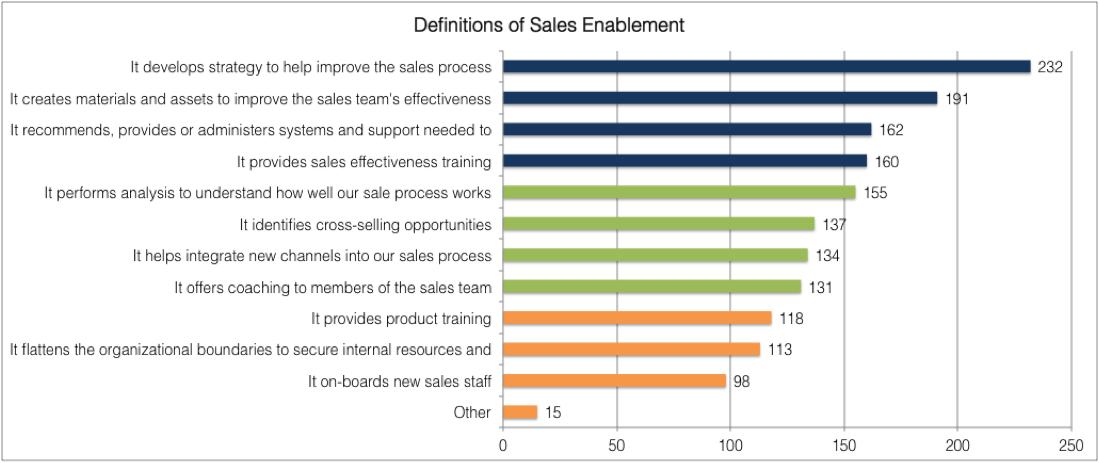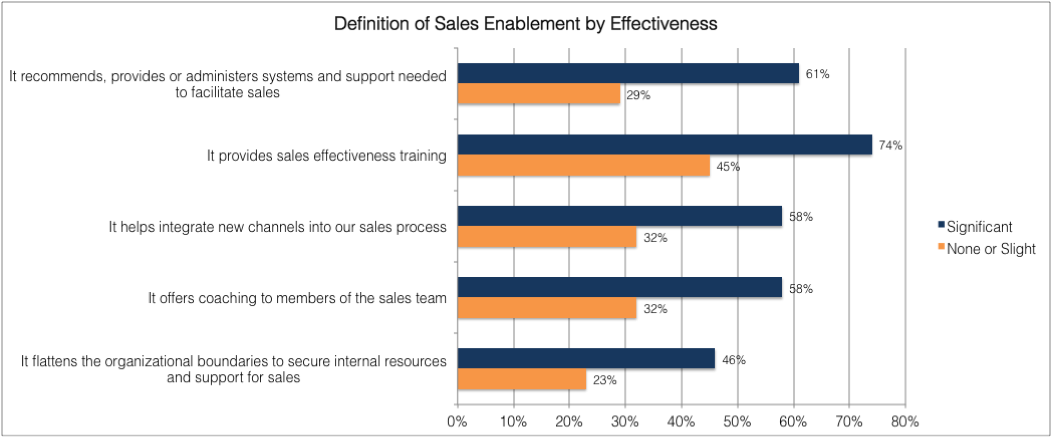Sales Enablement: What it Does
By Jerry Rackley
Demand Metric recently completed a benchmarking study on Sales Enablement, which yielded some insights and best practices for Sales Enablement. In this post, I want to share what the study revealed about what this function does.
A survey was used to collect data for the study, and the full report is available here. One half of survey participants indicated they had Sales Enablement as a function in their organizations. Regardless of whether a participant’s organization had the function, we wanted to know how they defined it in terms of what it does. So, we asked: “Which statement best characterizes your understanding of Sales Enablement?” Participants were presented with an array of response choices, and were allowed to select any that applied. Here are the results:
These results are interesting and make it pretty clear that the definition of Sales Enablement is fairly broad. A more practical view, however, would come from understanding how organizations define this function where Sales Enablement is working well. About one-third of survey participants reported their function as contributing significantly. By contrast, 18% of participants reported their function making no discernible contribution or only a slight one. Using these two groups as opposite ends of the Sales Enablement effectiveness spectrum, we looked for differences in how they define the function, and there were significant differences.
First, consider the areas where there was no statistically significant difference in the functional definition of Sales Enablement:
- It on-boards new sales staff
- It provides product training
- It identifies cross-selling opportunities
- It performs analysis to understand how well the sales process works
- It creates materials and assets to improve the sales team’s effectiveness
- It develops strategy to help improve the sales process
For each of the functional definitions listed above, regardless of how effective an organization’s Sale Enablement was, all organizations shared the same view regarding these definitions. In other words, both effective and ineffective functions report doing these things. Obviously, the organizations with effective Sales Enablement are doing a better job at them!
The divergence of opinion on the functional definitions based on effectiveness occurred in these areas:
This view of the data reveals some best practices. Organizations with effective Sales Enablement are far more focused on recommending, providing, administering and supporting systems that facilitate sales. They are also delivering sales effectiveness training and coaching far more than organizations reporting less effective Sales Enablement. An investment is being made to integrate new channels. Perhaps most importantly, the Sales Enablement function works as a “silo-buster” – helping flatten or minimize internal barriers to sales success. A participant in the webinar where we first reported these results shared that “If you cannot break down corporate silos, Sales Enablement will not be effective.”
It is clear that Sales Enablement is multi-faceted, with a multitude of functional definitions. But to have maximum effectiveness, there are some definitions that seem to contribute more to the function’s success than others. If you’re trying to build a Sales Enablement function, or boost the performance of an existing one, don’t overlook the five listed above where our research shows a relationship to effectiveness. For more insight on Sales Enablement, download the study report and reference the Demand Metric Sales Enablement Plan Methodology.



